Overview
To develop a stakeholder communication plan in project management, it is crucial to:
- Identify stakeholders
- Define their information needs
- Establish communication objectives
- Select effective channels and schedules for interaction
This article presents a comprehensive, step-by-step guide that underscores the significance of tailored messaging and regular updates. Such strategies are vital for fostering engagement and alignment among stakeholders, which ultimately drives project success and enhances business outcomes.
Introduction
In the realm of project management, effective communication with stakeholders stands as a cornerstone for success. As projects evolve, the necessity for a structured communication plan becomes increasingly vital, ensuring that all parties remain informed, engaged, and aligned with the project's objectives. This article delves into the intricacies of crafting a comprehensive stakeholder communication plan, highlighting essential steps from identifying stakeholders to evaluating communication effectiveness.
By exploring best practices and leveraging technology, organizations can foster a collaborative environment that not only mitigates risks but also enhances project outcomes. As the landscape of project management continues to shift, the emphasis on robust communication strategies will play a pivotal role in driving business success and achieving strategic goals.
Understanding Stakeholder Communication Plans
A party engagement strategy serves as a critical strategic document that delineates stakeholder communication in project management and details how information will be disseminated to interested parties throughout the duration of an initiative. This plan encompasses essential elements such as participant identification, their specific information needs, the frequency of updates, and the methods to be employed. By aligning all parties with the initiative's objectives and progress, the plan mitigates misunderstandings and nurtures a collaborative environment, which is vital for successful business turnaround strategies.
Key components of an effective stakeholder communication plan include:
- Stakeholder Identification: Recognizing all individuals or groups with a vested interest in the project is crucial for tailoring communication strategies effectively.
- Information Needs: It is essential to ascertain the specific information each participant requires to remain informed and engaged. This targeted approach enhances the relevance of communications and supports real-time analytics for performance monitoring.
- Communication Methods: Selecting appropriate channels for conveying information—such as emails, meetings, or reports—ensures that messages are transmitted effectively and reach interested parties promptly, facilitating swift decision-making.
- Frequency of Communication: Establishing a clear schedule for updates helps maintain engagement and ensures that stakeholders are informed of project developments, allowing for continuous monitoring of business performance.
Recent trends indicate that organizations are increasingly acknowledging the significance of stakeholder communication in project management as part of their structured communication plans. Companies that actively listen to their stakeholders have been shown to perform 15% better in achieving their strategic goals, as highlighted in the case study titled "Measuring Stakeholder Engagement Effectiveness." This study underscores that effective measurement of engagement can lead to improved success rates and overall business outcomes.
However, a significant challenge persists, as 41% of management professionals report difficulty in demonstrating the added value of their Management Office (PMO).
The importance of stakeholder communication in project management strategies cannot be overstated; they are essential to initiative success and business recovery efforts. Effective interaction is crucial for successful management, and efficient engagement strategies not only enhance participant involvement but also lead to superior results. As we advance through 2025, the emphasis on these plans will likely intensify, underscoring their essential role in aligning goals with the expectations of interested parties and driving overall business success.
The Importance of Stakeholder Communication in Project Management
Efficient stakeholder communication in project management is not merely beneficial; it is essential for successful management, acting as a catalyst for transparency, trust, and collaboration among all involved. When interested parties are consistently updated about developments, effective stakeholder communication significantly increases their likelihood of supporting the initiative and contributing positively to its success.
Key reasons why interaction with involved individuals is essential include:
- Alignment of Goals: Clear exchanges ensure that all parties comprehend the initiative's objectives and their respective roles in achieving them. This alignment is crucial for maintaining focus and direction throughout the lifecycle.
- Risk Mitigation: Stakeholder communication enables proactive dialogue that helps identify potential issues early, allowing for timely interventions to prevent minor setbacks from escalating into major problems. This foresight is essential for sustaining initiative momentum and reducing interruptions.
- Enhanced Engagement: Effective stakeholder communication encourages involved parties to offer valuable feedback and assistance, leading to better initiative outcomes. Studies show that companies thriving in community engagement are 40% more likely to finish tasks on schedule and within budget, underscoring the significance of cultivating robust connections. Furthermore, a Capterra study discovered that in general, 76% of users express they are either 'very satisfied' or 'satisfied' with their choice to utilize management software, emphasizing the positive influence of clear dialogue on success in endeavors.
- Conflict Resolution: Keeping open channels of dialogue permits the prompt resolution of misunderstandings and disputes before they intensify. This proactive method not only maintains relationships but also enhances the overall cohesion of the endeavor.
The influence of efficient stakeholder communication extends beyond immediate success; it cultivates a culture of collaboration that can result in sustainable growth. For example, case studies show that managers who apply practical solutions—such as clear messaging, regular updates, and effective stakeholder communication—can significantly improve participant engagement and satisfaction. Challenges in stakeholder communication, such as language barriers and misaligned expectations, can be mitigated through these strategies.
By prioritizing these methods, organizations can navigate the complexities of project management more effectively, ultimately leading to successful outcomes. Enhancing engagement techniques is crucial for business success, including improved documentation and prioritization to boost satisfaction and loyalty among involved parties.
Step 1: Identifying Stakeholders and Their Needs
The initial step in creating a communication plan for interested parties involves the thorough identification of all relevant individuals. This includes anyone with a vested interest in the undertaking, such as team members, clients, suppliers, and regulatory bodies.
To effectively identify interested parties, consider the following best practices:
- Create a Comprehensive Stakeholder List: Compile an exhaustive list of individuals and groups who are involved in or affected by the initiative. This foundational step ensures that no key participant is overlooked.
- Assess Influence and Interest: Evaluate the level of influence each participant wields over the project and their interest in its outcomes. Utilizing tools such as the Power/Interest Grid can facilitate this assessment, allowing for a visual representation of interest group dynamics.
- Understand Their Needs: Engage with involved parties to gain insights into their specific information requirements, preferences, and concerns. This can be accomplished through various methods, including surveys, interviews, or informal discussions. Effective stakeholder communication in project management is essential, as studies show that businesses excelling in this area experience increased sales, loyalty, and enhanced risk management. For instance, a biotech company with a high Employee Satisfaction Index (ESI) score demonstrated that effective engagement with involved parties can lead to low turnover and high productivity.
- Conduct Interest Group Analysis: Document the results of your interest group analysis, detailing their roles, positions, levels of support, and interests in the project. This organized method not only clarifies relationships among parties but also guides messaging strategies customized for each group. Emphasizing this documentation is critical, as it serves as a reference point for ongoing engagement efforts.
- Utilize Technology for Engagement: Employ technology-driven consulting services to enhance interaction and ensure that involved parties receive timely updates. Given that 39% of social media users prefer quick responses, implementing fast strategies for all involved groups is essential to maintain engagement and satisfaction.
By following these steps, project managers can effectively identify and engage participants, which is essential for successful stakeholder communication in project management and fostering a collaborative environment. The significance of participant involvement is further emphasized by case studies that showcase its effect on business success, stressing the necessity for thorough mapping and analysis of interactions.
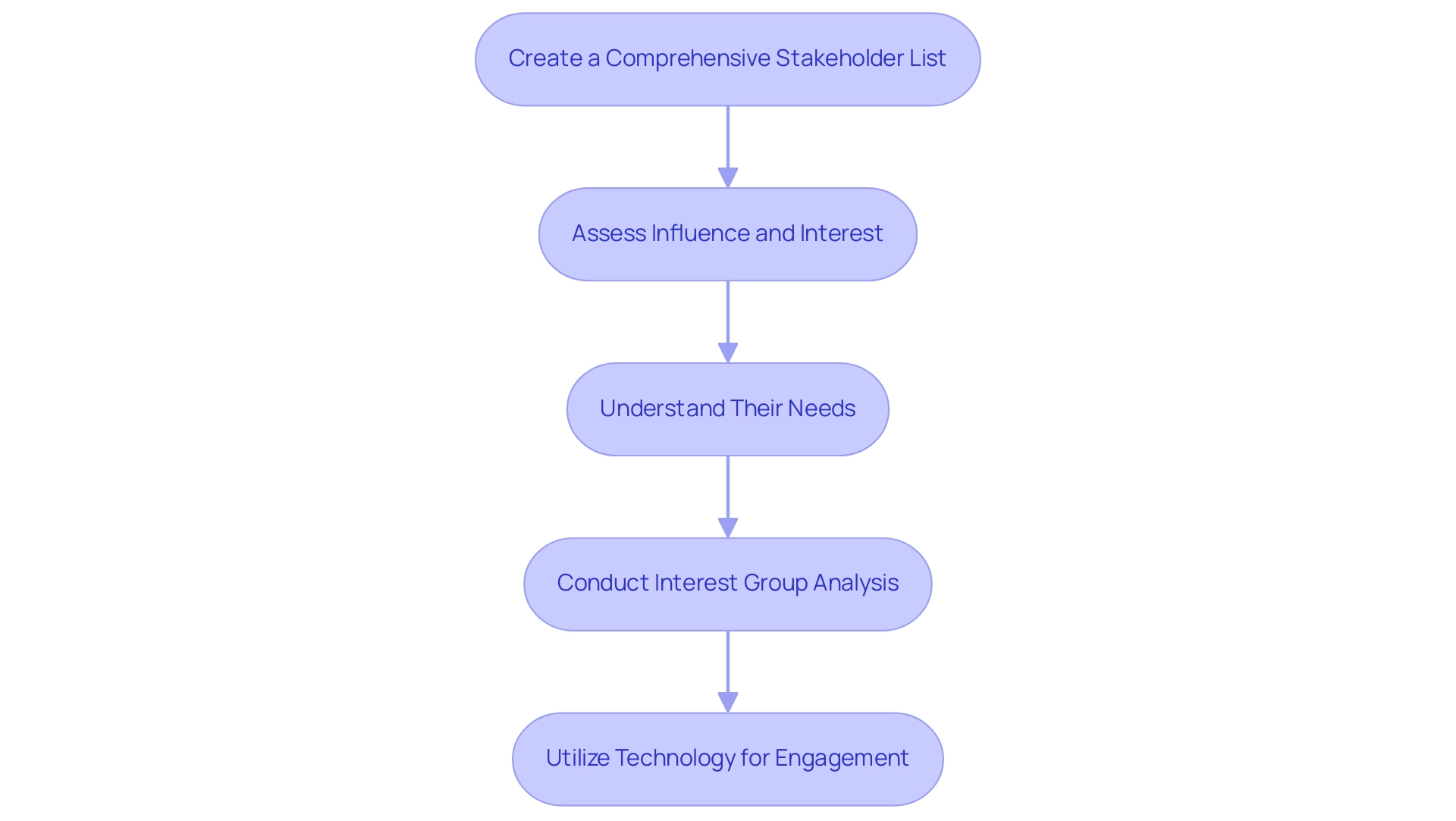
Step 2: Defining Communication Objectives
Once the parties involved and their needs have been identified, the next essential step is to define clear objectives for interaction. These objectives should adhere to the SMART criteria—specific, measurable, achievable, relevant, and time-bound—to ensure effective participant engagement.
To define communication objectives:
- Identify Key Messages: Determine the core messages that need to be communicated to each stakeholder group. This clarity aids in customizing messaging strategies that resonate with the audience.
- Set Goals: Establish what you aim to achieve with your outreach efforts. Objectives may involve raising awareness, encouraging participation, or requesting feedback, all of which are vital for sustaining interest and support from involved parties.
- Align with Initiative Objectives: Ensure that messaging aims are in harmony with the overall aims of the initiative. This alignment facilitates a cohesive approach to stakeholder communication in project management, which enhances the likelihood of project success.
The importance of establishing SMART objectives is underscored by the fact that organizations with efficient messaging strategies are 3.5 times more likely to surpass their peers. Additionally, a study revealed that 61% of high-performing organizations prioritize leadership training, highlighting the necessity for ongoing enhancement in interaction practices. This is particularly critical given that half of all Project Management Offices (PMOs) close within just three years, indicating struggles to demonstrate sustained value and alignment with organizational goals.
In successful projects, examples of SMART objectives might include increasing stakeholder engagement by 30% within the first quarter or achieving a 90% satisfaction rate in feedback surveys after project completion. These measurable targets not only guide outreach efforts but also provide benchmarks for evaluating success.
Expert insights suggest that defining interaction objectives is not merely a procedural step but a strategic necessity. As highlighted by industry leaders, including Jason Ballard, President of Soar Higher Coaching, "interaction on any team can always be enhanced." This emphasizes the significance of efficient dialogue in improving results, making it essential for managers to dedicate time to this crucial stage.
By setting clear, SMART goals for stakeholder communication in project management, teams can navigate complexities and cultivate stronger connections with involved parties, ultimately driving success. Moreover, the concepts of Lean Construction can transform the industry by enhancing efficiency and minimizing delays, further highlighting the potential advantages of effective interaction in management.
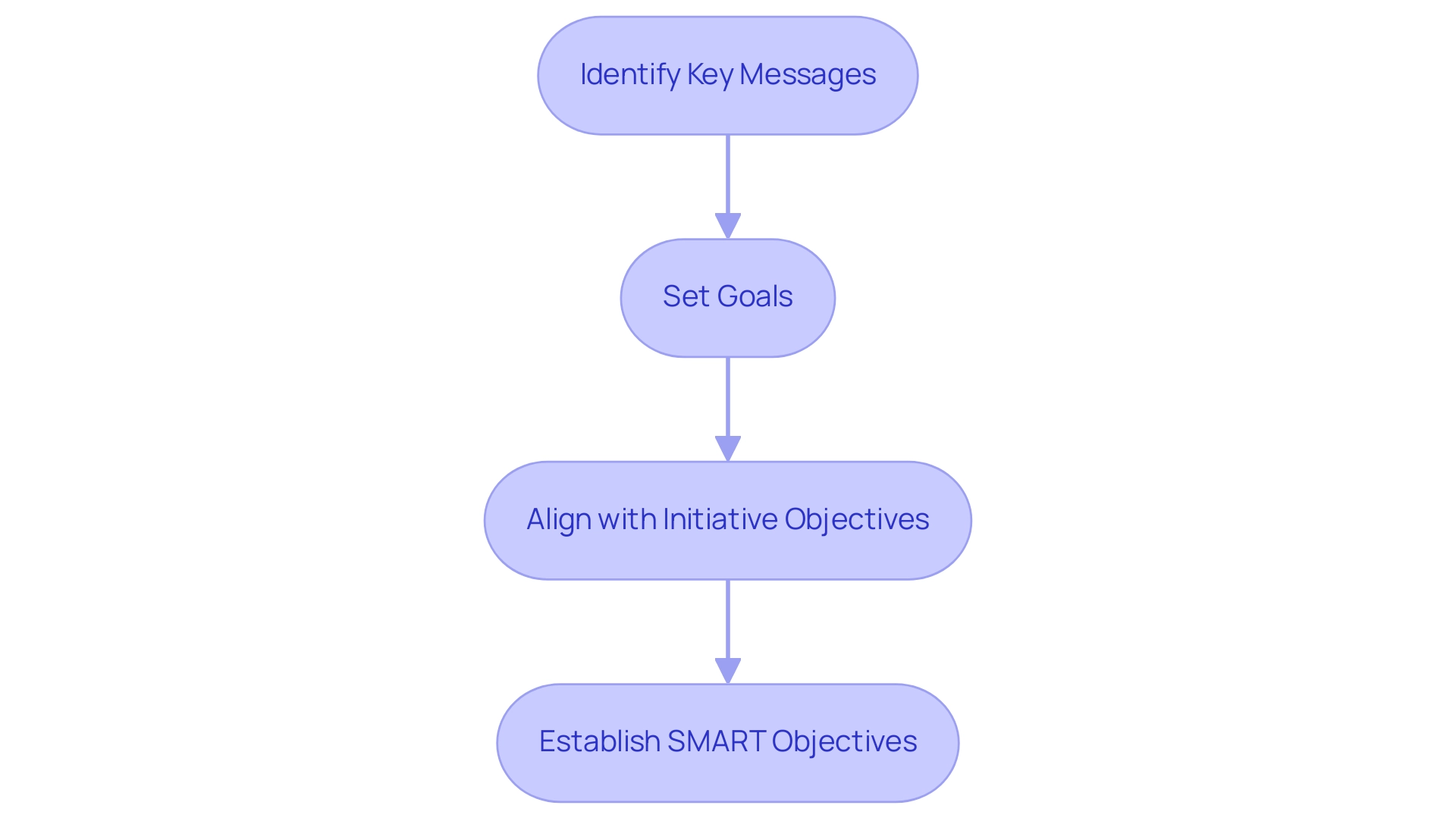
Step 3: Developing Key Messages for Stakeholders
Formulating essential messages is vital for ensuring that participants grasp the initiative's purpose and their specific roles within it. Effective communication in project management relies on messages that are clear, concise, and tailored to the unique needs of each stakeholder group, underscoring the importance of stakeholder communication in project management.
- Identify Core Themes: Establish the primary themes that need to be communicated, such as project goals, timelines, and expected outcomes. This foundational understanding sets the stage for effective messaging.
- Tailor Messages: Customize messages for various groups based on their interests and concerns. For instance, clients may require detailed information about deliverables and timelines, while team members might need updates on specific tasks and responsibilities. Studies indicate that 70% of change efforts fail due to inadequate dialogue with involved parties and insufficient engagement, highlighting the significance of this customized strategy. By aligning communication with the company's goal of assisting businesses in overcoming challenges, you can enhance engagement and drive better outcomes.
- Use Clear Language: Avoid jargon and technical terms that could confuse those involved. Instead, employ simple, straightforward language to convey messages effectively. Clear messaging is not merely a best practice; it is essential for fostering understanding and engagement among stakeholders, especially in stakeholder communication in project management.
- Leverage Digital Tools: Utilize digital tools and data analytics, such as those offered by Transform Your Small/Medium Business, to enhance engagement with interested parties. These resources can assist in mapping interests and priorities, enabling more informed and adaptive engagement strategies. Companies that effectively utilize stakeholder communication in project management often experience increased sales, loyalty, and improved risk management, demonstrating the tangible benefits of strategic communication. Additionally, the use of real-time business analytics can support continuous monitoring of performance, ensuring that interested parties remain informed of progress and challenges.
- Continuous Improvement: Regularly assess and refine your messaging strategies. Ongoing enhancement in engagement strategies, encompassing documentation and prioritization, is essential for success in capitalism. By remaining responsive to participant feedback and adjusting your communications accordingly, you can cultivate stronger connections and improve overall results. Furthermore, with 39% of social media users desiring quick responses, it is crucial to adopt rapid strategies for all involved parties, guaranteeing that interactions remain timely and pertinent. By adhering to these steps, you can create key messages that resonate with those involved, ensuring they are informed, engaged, and aligned with the project's goals, ultimately aiding in the success of your crisis management and restructuring efforts.
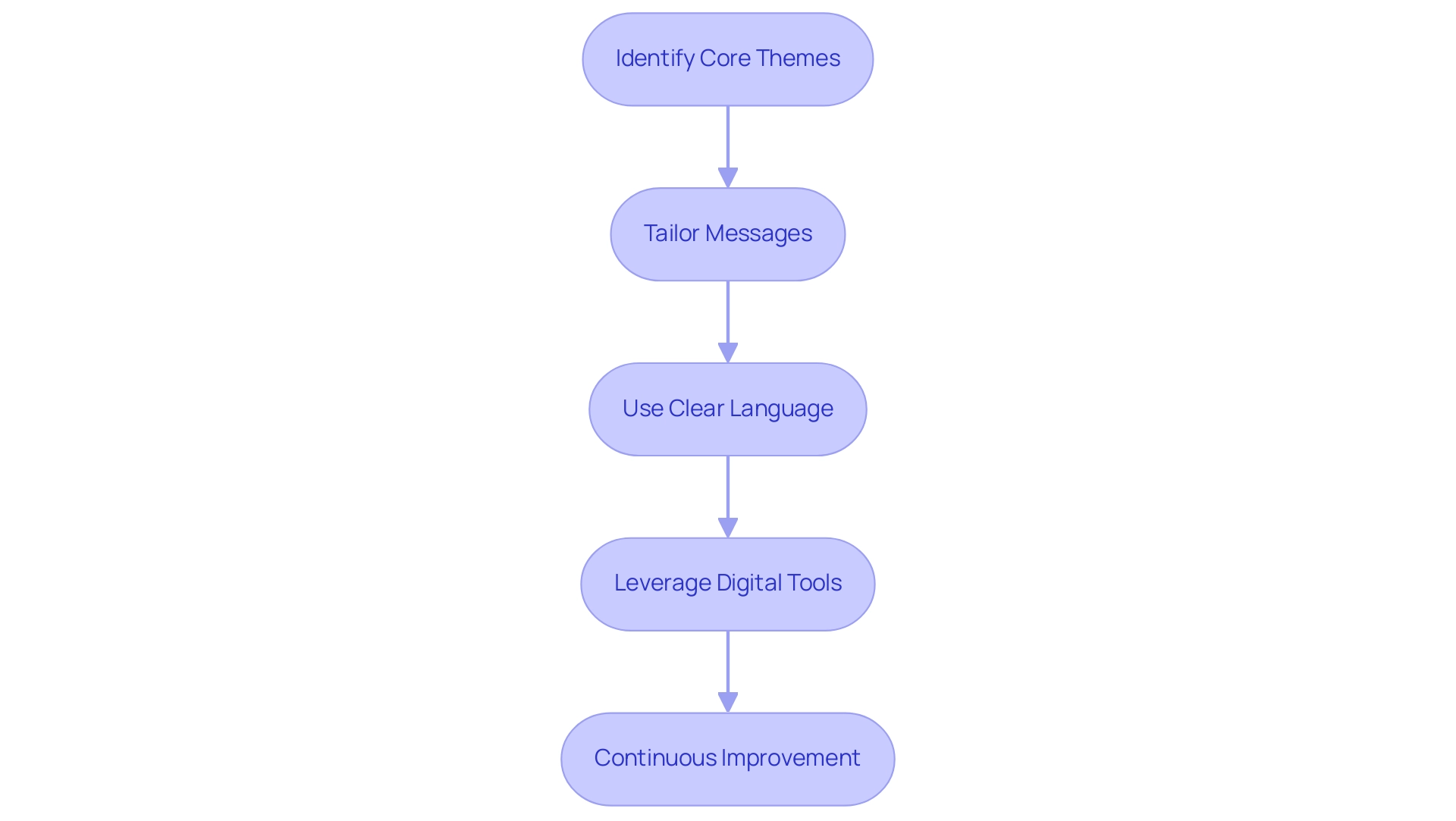
Step 4: Choosing Effective Communication Channels
Choosing suitable channels for interaction is crucial for effective stakeholder communication in project management, ensuring stakeholders receive timely and accessible information. Customizing stakeholder communication is essential, as preferences often vary based on roles and personal interaction styles. Moreover, integrating streamlined decision-making and real-time analytics can significantly enhance interaction effectiveness during critical turnaround processes.
To select effective communication channels, consider the following steps:
- Assess Interested Parties' Preferences: Conduct surveys or interviews to gather insights on preferred methods for receiving updates. Options may include email, meetings, newsletters, or social media platforms. Understanding these preferences enhances engagement and information retention, particularly in stakeholder communication within project management, especially when paired with real-time analytics that provide immediate insights into business health.
- Consider the Nature of the Message: Evaluate the complexity and sensitivity of the information being communicated. Sensitive topics may necessitate face-to-face meetings to foster trust and clarity, while routine updates can be effectively disseminated through emails or newsletters. Utilizing real-time business analytics also helps tailor messages to the current state of the organization, ensuring relevance and timeliness.
- Utilize Multiple Channels: Implement a diverse mix of channels to ensure comprehensive coverage. This strategy accommodates different stakeholder preferences and mitigates the risk of important messages being overlooked. Studies indicate that proficient stakeholder communication in project management can serve as a competitive edge, addressing issues like collaboration crises and leadership dialogue obstacles. As noted by Naqvi and Aziz, stakeholder communication in project management remains efficient when there is organized information flow and an official framework, which can be supported by real-time analytics.
- Establish a Reporting Hierarchy: Create a structured information flow by establishing a clear reporting hierarchy among team members. This framework facilitates timely updates and accountability, crucial for effective stakeholder communication in project management, ensuring all parties are informed of project developments. The D-R ranking emphasizes the significance of such structures, with values of 25 and 12 indicating effective interaction practices. Streamlined decision-making processes can further enhance this structure, allowing for quicker responses to the needs of involved parties.
- Monitor and Adapt: Regularly evaluate the effectiveness of selected channels of interaction. Collecting feedback from stakeholders is essential for effective stakeholder communication in project management, providing valuable insights into their preferences and the overall effect of strategies. Modifications may be necessary to improve engagement and ensure that interaction remains productive. The case study titled 'Future Research Directions in Project Communication' emphasizes the need for broader criteria in strategies, suggesting that future research should explore barriers to implementing effective factors. Ongoing observation via real-time analytics can assist in this assessment, ensuring that interaction strategies evolve with the requirements of involved parties.
By strategically choosing and overseeing interaction avenues, managers can enhance stakeholder communication in project management and cultivate stronger relationships with interested parties to improve outcomes. Recent studies emphasize that the obstacles to successful stakeholder communication in project management can be resolved through a blend of customized strategies and continuous assessment. Ultimately, these efforts align with the organization's mission to help businesses overcome challenges and achieve sustainable growth.
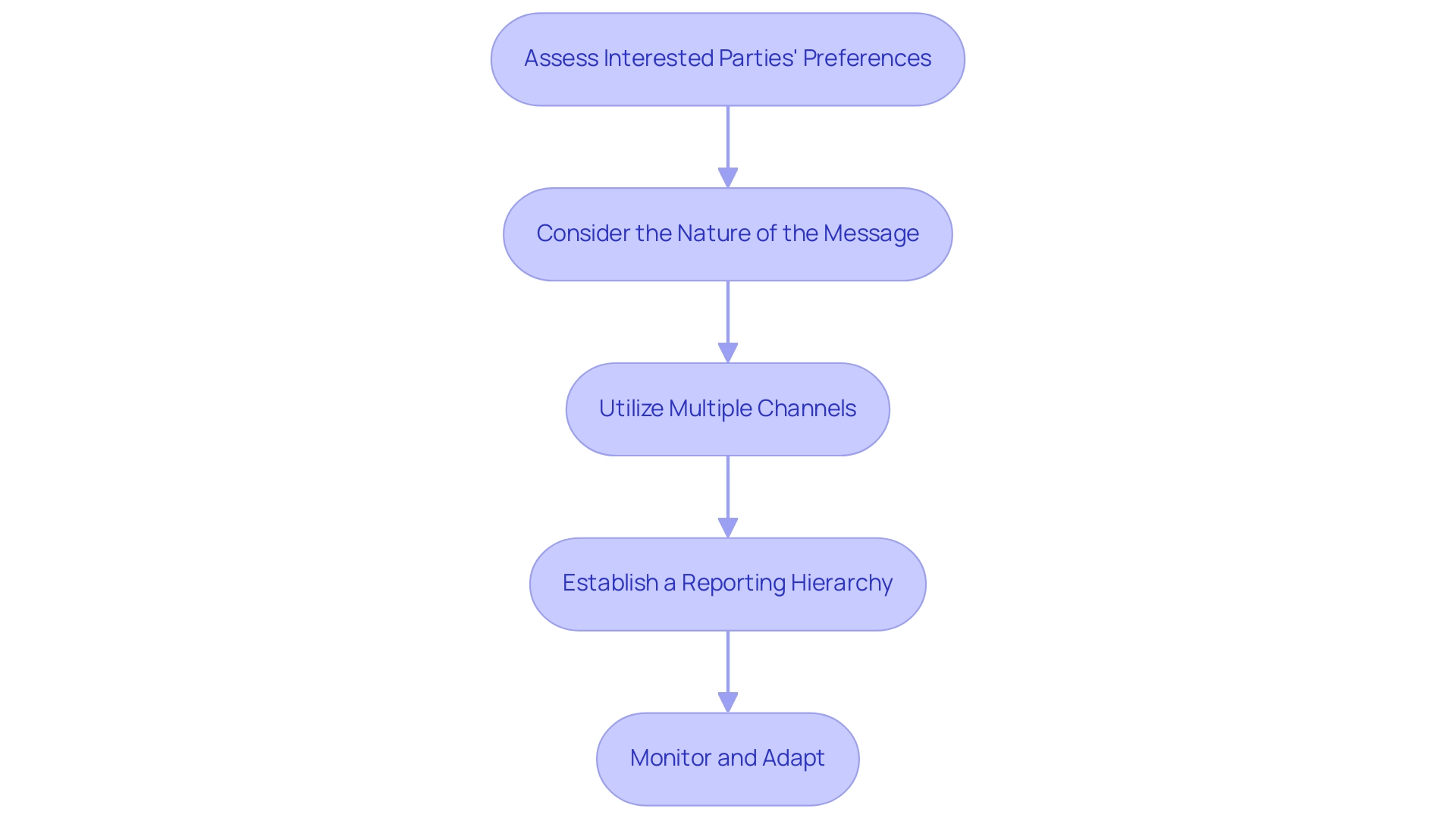
Step 5: Establishing a Communication Schedule
Establishing a contact schedule is crucial for facilitating effective stakeholder communication in project management. It ensures regular interaction with interested parties and provides prompt updates throughout the project’s duration. A well-structured messaging plan is fundamental to fostering stakeholder communication, which is vital for building the trust and collaboration necessary for successful project outcomes.
To create an effective correspondence schedule, consider the following steps:
- Determine Frequency: Assess how often updates will be provided to interested parties. Research indicates that nearly half of government relations experts dedicate between 6 to 10 hours weekly to stakeholder communication in project management, underscoring the need for a structured approach. Depending on the dynamics of the initiative, updates could be scheduled weekly, bi-weekly, or monthly.
- Align with Milestones: Schedule communications around key milestones to ensure that interested parties are informed of significant progress and any changes that may arise. For instance, in successful endeavors, timely updates correlated with milestone achievements have proven to enhance stakeholder communication and overall engagement.
- Use a Calendar Tool: Leverage management tools or calendar applications to set reminders for interaction tasks. This practice not only assists in sending updates promptly but also enables tracking interaction history, advantageous for future reference.
Incorporating regular updates into your messaging schedule is vital. A study shows that organizations employing organized messaging strategies experience enhanced stakeholder communication and improved relationships with interested parties. Furthermore, professional guidance suggests that maintaining a steady interaction rhythm can significantly bolster stakeholder communication, enhancing trust among involved parties and the transparency of the initiative.
As highlighted, 39% of social media users desire quick responses, emphasizing the importance of prompt interaction in engaging interested parties.
Additionally, consider the case study of Simply Stakeholders, which provides a tool designed to enhance the management of interested parties through features like contact records and sentiment analysis. This tool streamlines engagement management, enabling organizations to refine their strategies and interactions with involved parties.
By establishing a clear interaction schedule, managers can enhance stakeholder communication in project management, ensuring that participants remain informed and engaged, ultimately leading to more successful execution of initiatives. Adobe's impressive 85+ Net Promoter Score (NPS) for participant satisfaction serves as a benchmark for effective interaction practices, demonstrating the positive impact of a robust participant engagement strategy.
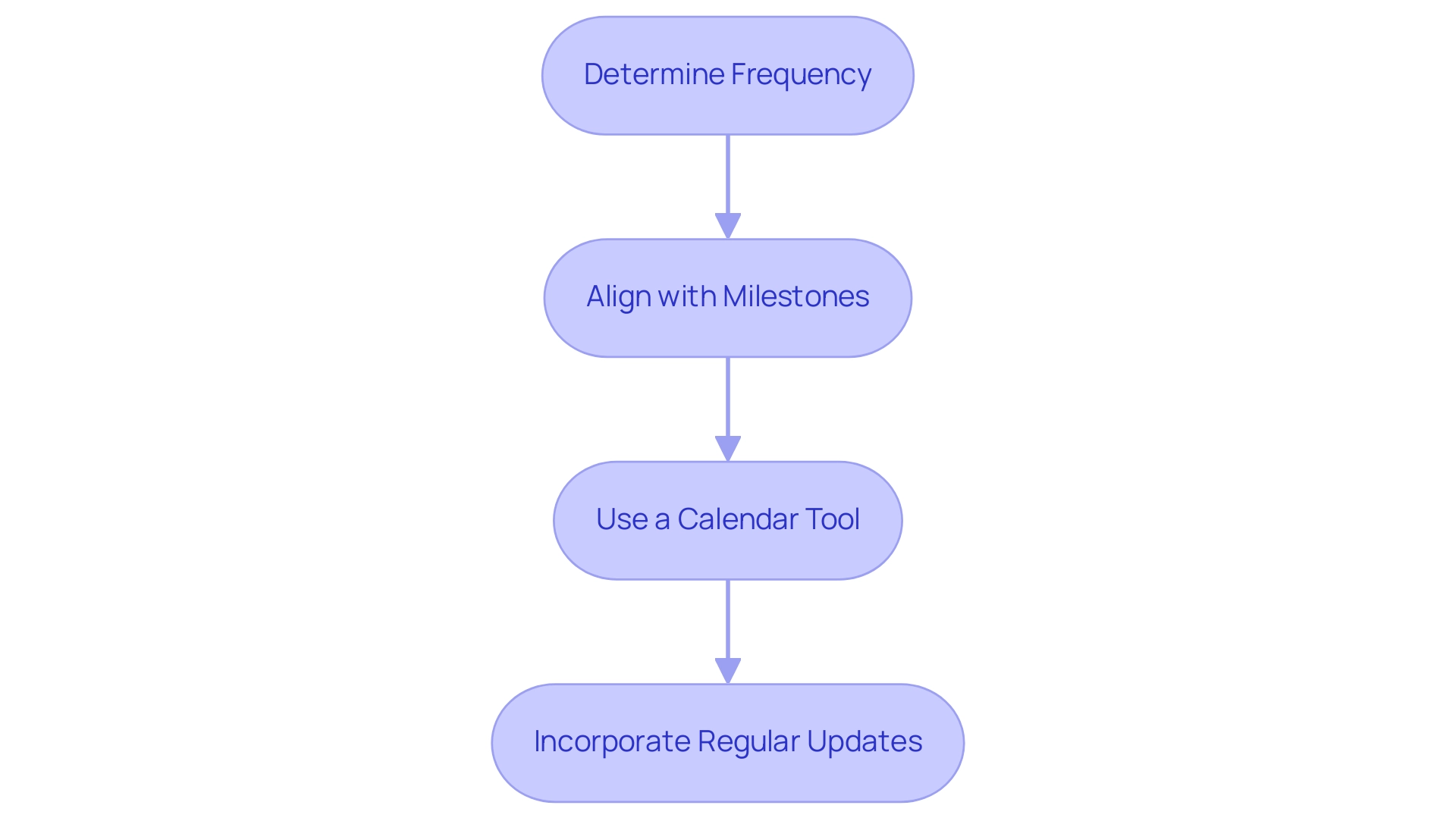
Step 6: Designating Communication Responsibilities
Assigning information duties is vital for ensuring that all participants receive uniform and precise details throughout the initiative. Effective stakeholder communication in project management not only promotes transparency but also enhances participant engagement, which is essential for project success.
To assign communication responsibilities effectively:
- Identify Team Members: Determine which team members will be responsible for communicating with specific groups of interest. This ensures that each participant receives tailored information relevant to their interests and concerns.
- Define Roles: Clearly outline the roles and responsibilities of each team member in relation to stakeholder interaction. For instance, project managers may handle high-level updates, while team leads focus on specific departmental interactions. This delineation enhances stakeholder communication in project management by preventing overlaps and gaps in information dissemination.
- Establish Accountability: Hold team members responsible for their tasks by setting clear expectations and deadlines for updates. Research indicates that 69% of employees would work harder if they felt appreciated, highlighting the importance of recognition in maintaining morale and engagement. By promoting a culture of accountability, teams can ensure that stakeholder communication in project management is prompt and impactful. As highlighted by Forbes, firms with the finest corporate cultures that promote leadership initiatives and employee acknowledgment increased 682% in revenue, emphasizing the substantial influence of efficient messaging strategies.
Incorporating best practices, such as utilizing digital signage for continuous updates, can significantly improve stakeholder communication in project management and enhance information-sharing efficiency. A case study demonstrated that organizations using digital signage reduced time spent on emails and briefings, thereby boosting productivity and fostering a culture of accountability. Moreover, statistics indicate that 48% of knowledge workers are more inclined to address concerns swiftly when engaged with in a positive tone, highlighting the effect of interaction style on participant responsiveness.
Furthermore, tools such as Oak Engage enable organizations to assess and analyze the efficiency of their internal interactions, ensuring that participant engagement is both impactful and aligned with initiative goals.
By applying these strategies, organizations can develop a strong framework for participant engagement that not only aids initiative objectives but also fosters a collaborative atmosphere favorable to success.
Step 7: Anticipating and Mitigating Communication Risks
Foreseeing and addressing interaction risks is essential for maintaining effective stakeholder involvement throughout the initiative lifecycle. High-performing organizations understand that proactive message management can significantly enhance project outcomes.
To effectively address communication risks, consider the following steps:
-
Identify Potential Risks: Conduct a thorough assessment to pinpoint potential risks that may disrupt interactions. Common risks include changes in scope, stakeholder availability, and technological challenges. Significantly, statistics show that 41% of management offices (PMOs) find it challenging to demonstrate the added value of their outreach efforts, highlighting the need for vigilance in this area.
-
Develop Contingency Plans: Formulate comprehensive contingency plans tailored to the identified risks. This ensures that alternative means of interaction are readily available, allowing for seamless information flow even in the face of disruptions. For instance, organizations with formal training programs in project management—60% of PMOs have established such programs—are more adept at implementing diverse messaging strategies, which can mitigate risks effectively. High-performing organizations also employ various training strategies, including PM software tool training and advanced PM skills development, to enhance their management capabilities.
-
Monitor Interaction Effectiveness: Regularly assess the effectiveness of your strategies for interaction. This entails gathering feedback from involved parties and making necessary adjustments to address any emerging risks. Case studies demonstrate that organizations that actively observe and adjust their interaction strategies are better equipped to foresee and alleviate potential problems, resulting in enhanced participant satisfaction and initiative success. As one advisor observed, 'He ought to have included 'bankrupting,'' emphasizing the crucial importance of clear interaction in preventing task pitfalls.
By adopting these strategies, managers can improve their capacity to handle interaction risks, ensuring that participant involvement remains robust and efficient throughout the initiative. Furthermore, utilizing technology-driven consulting services can aid in comprehending distinct client requirements and priorities, further enhancing effective risk management.
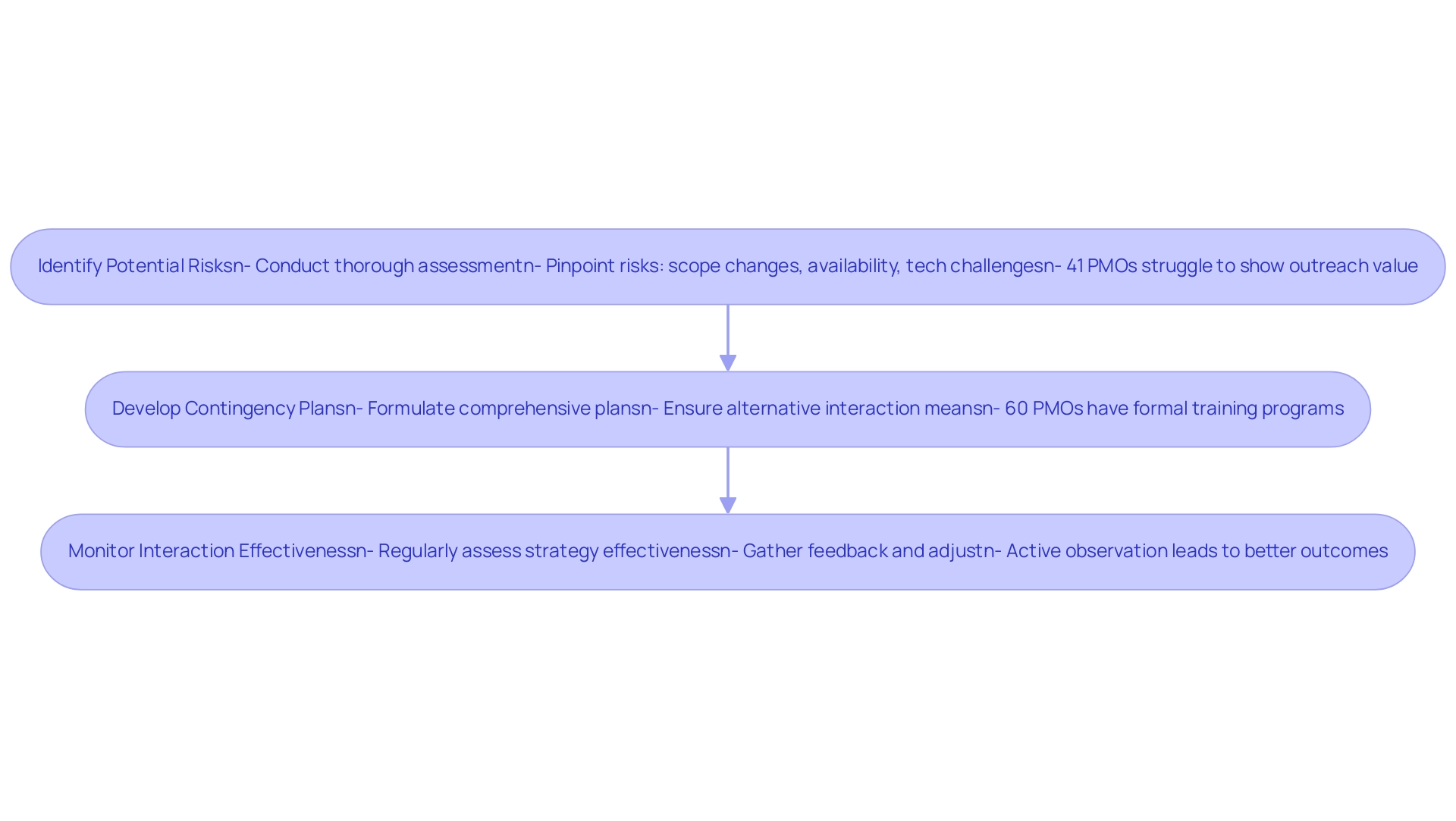
Step 8: Gathering Feedback and Evaluating Communication Effectiveness
Collecting input and assessing interaction effectiveness is crucial for sustaining stakeholder communication in project management and ensuring that participants are well-informed throughout the project lifecycle.
To effectively collect input:
- Implement Feedback Mechanisms: Establish a variety of feedback channels such as surveys, interviews, and informal discussions. These tools enable participants to share their views on the interaction process, nurturing an atmosphere of open dialogue.
- Analyze Feedback: Systematically review the collected feedback to pinpoint areas needing improvement. This analysis is essential for evaluating the effectiveness of current messaging approaches and understanding stakeholder communication in project management regarding the feelings of interested parties. Qualitative research through interviews with managers can complement this quantitative data, providing deeper insights into the perspectives of involved parties.
- Make Adjustments: Leverage the insights gained from feedback to refine the messaging strategy. This iterative process ensures that stakeholder communication in project management remains aligned with the expectations and needs of involved parties.
Research indicates that organizations can enhance their performance significantly through effective stakeholder communication in project management, with companies demonstrating a 15% improvement in their strategic plans. Furthermore, employees who receive daily feedback are 3.6 times more likely to feel motivated to excel in their work compared to those who receive feedback annually. This emphasizes the significance of stakeholder communication in project management, highlighting the need for consistent interaction and feedback systems to cultivate a motivated and involved group of interested parties.
For example, TeleTech, a call center, successfully lowered employee turnover by 15% within a year by implementing regular check-ins and pulse surveys to assess employee sentiment. Following these initiatives, TeleTech found that employee turnover decreased considerably, highlighting the effectiveness of organized feedback systems in enhancing stakeholder communication in project management to improve interaction and engagement.
In summary, the significance of assessing participant interaction cannot be overstated. By implementing robust feedback systems, organizations can enhance stakeholder communication in project management, improving their agility and responsiveness, ultimately leading to more successful outcomes.
Step 9: Utilizing Technology and Tools for Communication
Utilizing technology and resources for interaction can significantly enhance the efficiency and effectiveness of participant engagement in management. By adopting the right strategies, organizations can improve stakeholder communication in project management and foster better relationships while ensuring that all parties are aligned throughout the lifecycle.
Choose Suitable Tools: Start by determining tools for interaction that align with stakeholder preferences and fulfill task requirements. Choices may consist of management software, email platforms, and collaboration tools that enable seamless interaction. The right tools can also support a shortened decision-making cycle, allowing teams to take decisive actions that preserve business health during turnaround processes at Transform Your Small/ Medium Business.
Implement Interaction Platforms: Utilize platforms designed for real-time interaction and collaboration. These tools not only enhance stakeholder communication in project management by keeping interested parties informed but also promote active involvement, which is essential for success. For instance, integrating digital communication technology can significantly contribute to growth and success when used securely, highlighting the importance of safeguarding sensitive information during interactions. Moreover, real-time business analytics, accessible through our client dashboard, can continually monitor the success of plans and teams, thereby enhancing stakeholder communication in project management to ensure that stakeholders are engaged and informed about the project's progress.
Train Team Members: It is essential to provide training for team members on the effective use of selected tools. This ensures that everyone is equipped to maximize the potential of these technologies, ultimately improving interaction and engagement. Continuous performance monitoring through these tools can help teams adjust strategies based on real-time feedback, fostering a culture of responsiveness and adaptability. The effectiveness of messaging tools in project management is underscored by statistics indicating that personalized push notifications can increase reaction rates by up to 400%. This emphasizes the significance of customizing messaging strategies to enhance stakeholder communication in project management.
Furthermore, case studies show that the emergence of modern technology has changed organizational interactions, thereby improving stakeholder communication in project management and making them more responsive to feedback. For instance, the case study titled 'Modern Communication Technology & Public Relations' demonstrates how companies that concentrate on providing high-quality service and handling negative feedback effectively can foster loyalty and trust among interested parties. As Lena Radosavljevic aptly states, 'Knowing how to use technology the right way can bring your business to the pinnacle of success.' In 2025, the latest technological tools for participant interaction will continue to develop, providing innovative solutions that improve engagement and simplify project management processes. By remaining updated on these developments, organizations can guarantee they are using the best resources available to promote successful interactions. Furthermore, it is essential to consider data quality standards and processes for emerging needs, as emphasized in the GAO's report, to ensure that tools are effective and reliable.
Step 10: Documenting and Archiving Communication Efforts
Recording and archiving outreach efforts is essential for preserving a complete account of participant interactions and the choices made during the project lifecycle. Effective message management not only fosters transparency but also enhances accountability among team members and stakeholders, which is crucial for effective stakeholder communication in project management.
To systematically document messaging efforts:
- Establish a Correspondence Record: Create a comprehensive log that documents all interactions with interested parties. This log should include the date of contact, topics discussed, key decisions made, and any follow-up actions required. This practice not only aids in tracking progress but also serves as a reference for future discussions.
- Archive Important Documents: Establish a centralized repository for storing essential documents, such as meeting notes, reports, and stakeholder feedback. This ensures that all relevant information is easily accessible, facilitating informed decision-making and reducing the risk of miscommunication.
- Review and Reflect: Schedule regular reviews of archived messages to extract lessons learned and identify areas for improvement. This reflective practice can significantly enhance management effectiveness, especially in tackling challenges like scope creep, which impacts 28% of initiatives in soft skill-focused companies.
Incorporating these practices not only streamlines coordination but also aligns with expert recommendations on the significance of documenting interactions. By maintaining thorough records, organizations can better navigate complexities in management, such as those highlighted in case studies that reveal the impact of remote work on employee burnout and the need for formal processes. Furthermore, effective documentation and archiving of stakeholder communication in project management contribute to a more organized and successful management approach, ultimately supporting the value of management specialists, who earn a median pay of $94,500 per year according to the BLS.
Moreover, using management software can save employees an average of 498 hours annually, further improving efficiency. Ultimately, these practices contribute to a more organized and successful project management approach.
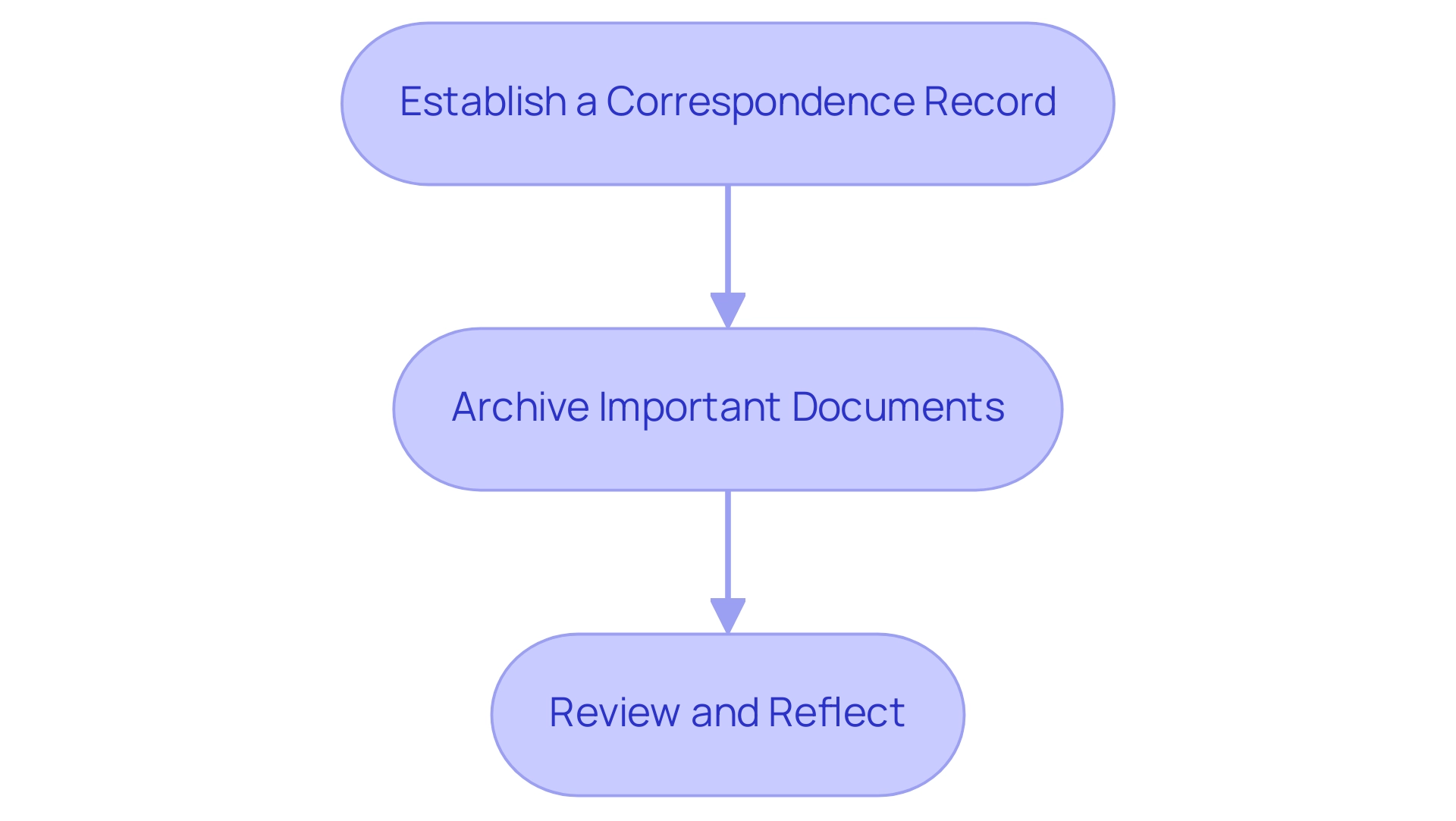
Conclusion
Effective stakeholder communication is not merely a procedural necessity; it is a strategic imperative that underpins the success of any project. This article has underscored the importance of crafting a comprehensive stakeholder communication plan, emphasizing steps from identifying stakeholders to evaluating communication effectiveness. Each step plays a critical role in fostering transparency, trust, and collaboration, ensuring that all parties are aligned and informed throughout the project lifecycle.
By focusing on structured communication strategies, organizations can mitigate risks, enhance stakeholder engagement, and ultimately improve project outcomes. Moreover, the integration of technology and continuous feedback loops supports this endeavor, allowing for real-time adjustments that cater to the evolving needs of stakeholders. As the complexities of project management continue to grow, the significance of robust communication plans will only increase, serving as a cornerstone for achieving strategic business goals.
In conclusion, prioritizing effective stakeholder communication is essential for navigating the challenges of project management. By implementing best practices and leveraging modern tools, organizations can create a collaborative environment that drives success, ensuring that every stakeholder remains an informed and engaged participant in the journey toward project completion. Consequently, as the landscape of project management evolves, the commitment to enhancing communication strategies will be a key differentiator in achieving lasting business success.
Frequently Asked Questions
What is a party engagement strategy in project management?
A party engagement strategy is a strategic document that outlines stakeholder communication and details how information will be shared with interested parties throughout a project. It includes participant identification, their information needs, frequency of updates, and communication methods.
Why is stakeholder communication important in project management?
Stakeholder communication is essential for successful management as it fosters transparency, trust, and collaboration. It helps align goals, mitigate risks, enhance engagement, and facilitate conflict resolution, ultimately leading to better project outcomes.
What are the key components of an effective stakeholder communication plan?
The key components include: Stakeholder Identification: Recognizing all individuals or groups with an interest in the project. Information Needs: Understanding the specific information each participant requires. Communication Methods: Selecting appropriate channels for conveying information. Frequency of Communication: Establishing a schedule for updates to keep stakeholders informed.
How can stakeholder communication mitigate risks in a project?
Effective stakeholder communication enables proactive dialogue that helps identify potential issues early, allowing for timely interventions to prevent minor setbacks from escalating into major problems.
What benefits arise from enhanced stakeholder engagement?
Enhanced stakeholder engagement leads to better initiative outcomes, with studies showing that companies excelling in community engagement are 40% more likely to complete tasks on schedule and within budget.
What are the best practices for identifying stakeholders?
Best practices include: Creating a comprehensive stakeholder list. Assessing influence and interest using tools like the Power/Interest Grid. Understanding their needs through surveys or discussions. Conducting interest group analysis to document roles and interests. Utilizing technology for timely updates and engagement.
How does effective stakeholder communication impact overall business success?
Effective stakeholder communication can lead to increased sales, loyalty, and enhanced risk management, contributing to improved business outcomes and success rates in achieving strategic goals.




